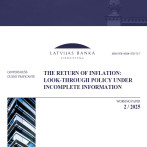Inflation remained atypically low in October
In October, annual inflation still remained atypically low, with the average consumer prices at the level equivalent to that observed in October 2012.
Declining fuel prices, seasonal reduction in potato prices as well as falling travel and hotel service prices due to the end of the tourist season were the major factors affecting consumer prices over the month. An opposite, upward, impact on inflation was exerted by another seasonal factor, offering of autumn/winter clothing and footwear for sale (such a price rise is typical of September and October), and probably also by the price-setting policy of companies. Overall, consumer prices increased by 0.3% in October, thus not exceeding average price growth in a longer term observed in October.
Currently, the developments of global oil and food prices have opposite effects on inflation. Oil price has shrunk by around 15 US dollars per barrel since mid-September and has a favourable impact on other energy prices. However, the data presented by the Food and Agriculture Organisation of the United Nations (FAO) on the global agricultural and food prices reported a minor growth in October. This development was observed in all major commodity groups (sugar in particular) where a price decline, driven by an expansion in manufacturing, had been evidenced over a longer period of time. However, long-lasting incessant rain in Brazil impaired harvesting. Some increase in food and agricultural product prices might be attributable to temporary factors.
This year the following prices rose at a faster pace than on average in October: the prices of catering services (by 1.3% over the month), cleaning of clothing (by 0.3%) and footwear repair (by 0.8%), as well as the prices of books and periodicals and office accessories (by 1.5%). The impact of prices of the above consumption groups on the overall monthly inflation was below 0.1 percentage point. Even if such an expansion might be associated with the beginning of the dual price display, assuming that the prices of the above groups increased at the same pace as in October 2012, the impact of this difference on the average inflation of 2013 would only be 0.01 percentage point.
"Convenient" prices ending with 0- or 5-santims are common for a number of services, such as public catering, cleaning of clothing and personal grooming services. However, it is evident even from the data of price monitoring that, with the beginning of the dual price display, not all such prices have been adjusted to the closest round price (convenient price) in terms of euro. Moreover, prices have been adjusted/ both to a lower "round price" and a higher one. It should be noted that a display of round prices in terms of euro already points to the willingness of businesses to retain the same price for a sufficiently long period of time also after the euro changeover since it would not be worth to display "inconvenient" prices for three months otherwise.
Data for January–October suggest that the annual inflation in 2013 will be the lowest against the background of positive growth. Nonetheless, annual inflation might remain atypically low at the beginning of 2014 as well. Despite a minor rise in excise tax on tobacco and autogas, other prices, e.g. heating tariffs, might be lower than in the respective period of the previous year. Heating tariffs are expected to decline in a number of towns in the coming months (apart from volatility of natural gas prices). For instance, a reduction can be expected in Liepāja, Ventspils and Jelgava already in December, while tariffs might fall in Daugavpils in the first quarter of 2014.
Textual error
«… …»






